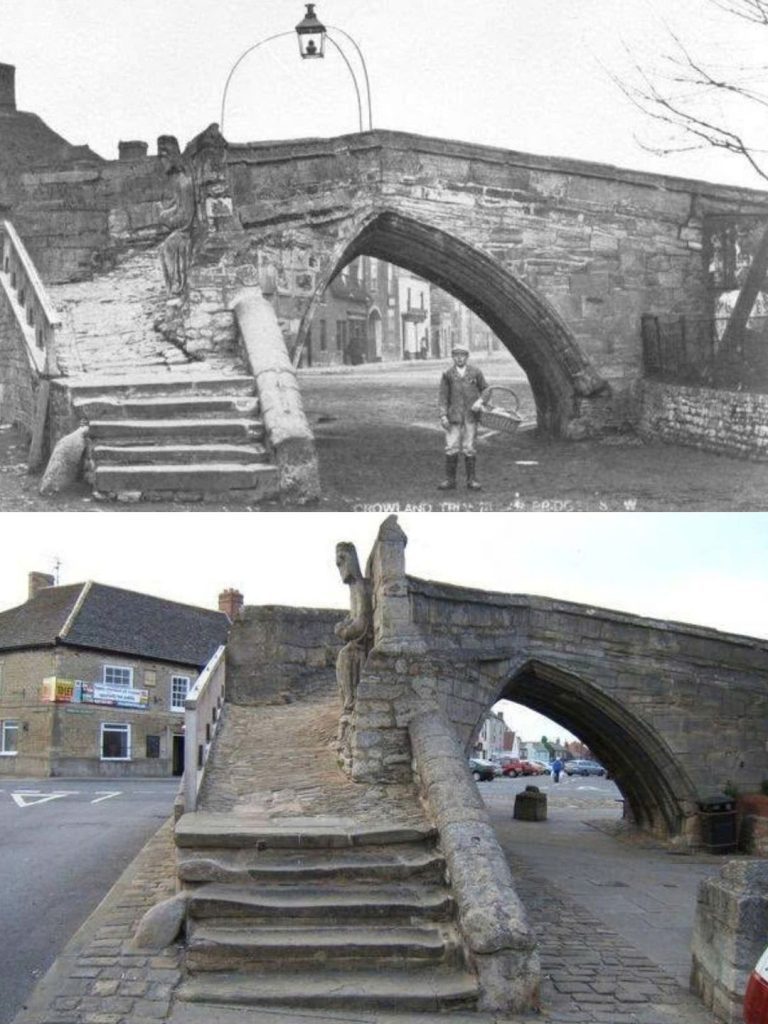Nestled in the heart of Crowland, Lincolnshire, England, the Trinity Bridge stands as a testament to the ingenuity and craftsmanship of medieval engineers. This extraordinary three-way stone arch bridge, built during the 14th century, remains an enduring symbol of architectural brilliance and historical significance. Its unique design and compelling history make it one of England’s most fascinating medieval landmarks.

Roots in Medieval England
The story of the Trinity Bridge stretches back centuries, with its origins deeply rooted in the early medieval period. The first recorded mention of a bridge at this site dates to 716 AD, during the reign of King Æthelbald of Mercia. Later, it appeared again in historical documents, such as King Eadred’s charter of 943 AD. However, the structure that stands today was constructed between 1360 and 1390, a time when bridges were essential to commerce and travel in medieval England.
The bridge originally spanned the meeting point of the River Welland and its tributary, serving as a vital crossing for travelers and merchants navigating the waterways. Its strategic location made it an indispensable feature of the region, connecting important trade routes and facilitating the exchange of goods and ideas.
The Bridge That Lost Its Rivers
In an unexpected turn of events, water management projects during the mid-17th century altered the course of the rivers the Trinity Bridge once traversed. The rivers were redirected as part of drainage efforts to reclaim surrounding marshlands for agriculture. This left the bridge standing alone on dry land, disconnected from the waterways it was built to span. While this might have rendered many structures obsolete, the Trinity Bridge gained an air of mystique, becoming an emblem of adaptation and historical preservation.
A Marvel of Medieval Architecture
The Trinity Bridge is a masterpiece of design and engineering, showcasing the skill and creativity of medieval builders. Constructed from Barnack stone, a durable limestone quarried just 10 miles west of Crowland, the bridge reflects meticulous craftsmanship. Transporting the stone to the construction site via the River Welland underscores the very function the bridge was intended to fulfill.
Its most distinctive feature is its three stairways that converge at a central point, forming a three-way bridge unlike any other. This ingenious design eliminated the need for multiple separate bridges, solving a logistical challenge while creating a visually striking structure. The bridge’s three abutments and converging stairways were a practical response to the confluence of waterways, highlighting the problem-solving prowess of medieval architects.
Engineering Excellence
The innovative design of the Trinity Bridge stands as a testament to the resourcefulness of medieval engineers. By combining functionality with artistry, they created a structure that not only served its purpose but also became an enduring monument. The bridge’s three-way layout allowed it to span two intersecting waterways efficiently, providing an elegant solution to a complex geographical challenge.
This remarkable engineering achievement reflects the medieval emphasis on blending practicality with aesthetics. The Trinity Bridge was not merely a utilitarian structure; it was a work of art that demonstrated the builders’ deep understanding of both form and function.
A Living Monument
Centuries after its construction, the Trinity Bridge continues to captivate visitors and historians alike. It is now a protected heritage site, designated as both a scheduled monument and a Grade I listed structure. These designations underscore its exceptional architectural and historical importance, ensuring its preservation for future generations.
Beyond its status as a heritage site, the Trinity Bridge serves as an invaluable educational resource. For students of history, engineering, and architecture, it offers a tangible connection to the past. Its unique design and adaptation to changing environmental conditions provide insights into medieval engineering practices and the societal needs of the time. The bridge stands as an outdoor classroom, inspiring curiosity and learning.
The Bridge That Defied Time
Despite no longer spanning flowing waters, the Trinity Bridge remains a powerful symbol of resilience and innovation. Its enduring presence in the Crowland landscape is a reminder of humanity’s ability to adapt and innovate in the face of change. As a bridge between the past and the present, it connects us to the ingenuity of our medieval ancestors.
The Trinity Bridge is more than just a relic of the past; it is a living testament to the enduring spirit of human creativity. Its story is one of transformation, from a functional crossing to a historical monument, and it continues to inspire admiration and wonder. Standing proudly in Crowland, the bridge invites us to reflect on the achievements of those who came before us and to appreciate the rich tapestry of history that shapes our world today.
Conclusion
The Trinity Bridge of Crowland is a marvel of medieval engineering, a symbol of adaptability, and a treasure of British heritage. Its unique design, fascinating history, and continued relevance make it a landmark worth celebrating. As we stand in awe of its enduring beauty, we are reminded of the remarkable ingenuity and skill of the medieval builders who created it. The Trinity Bridge is not merely a bridge; it is a bridge through time, connecting us to a past filled with innovation and creativity.





